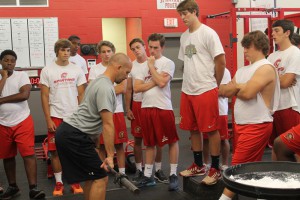Sep 1, 2016Five Core Principles
At the Greater Atlanta Christian School in Norcross, Ga., we use many methods to make our student-athletes the best they can be. We monitor hydration, focus on recovery, and provide education on nutrition. We carefully construct workout routines and teach athletes well.
But the basis of our program starts with five core principles. New ideas can not work without having an effective strength and conditioning program in place first. Here are the most important ideas behind what we do:
Do no harm: This refers to selecting drills to lower injury potential, as well as choosing modalities that provide the biggest reward with the least risk to the athlete.
Move well: Gray Cook, MSPT, OCS, CSCS, RKC, the creator of Functional Movement Systems, states, “Do not load dysfunction.” If we load a dysfunctional movement, we put the athlete at risk of injury and break our very first principle. Furthermore, if an athlete is inefficient in a movement, they will have to utilize other musculature and supportive tissues to complete it, reducing their ability to perform and placing them at risk of injury.

Move strong: It is important that high school athletes are proficient in bodyweight movements before external resistance is applied, so we look first to develop relative body strength. We determine strength to bodyweight goals for indicator exercises and allocate training based upon these relative strength scores.
Move fast: Once we have developed appropriate relative body strength, we pursue rate of force development. In movement-based training, we also want our athletes to master force production (reactive concentric), force absorption (eccentric loading), and force redirection (isometric control). An athlete with the ability to produce, absorb, and redirect force at a faster rate than the competition is difficult to beat.
Thrive: This is the most important principle of all. Coaches and athletes are involved in sport because it is fun! We must look for every opportunity to maximize the enjoyment of sport — it has to be about more than wins and scholarships.
Along with the above principles, we incorporate three key ideas into our program:
Unified (but not uniform) program: Offseason, preseason, and in-season athletes all need a specific training emphasis that a uniform program cannot provide. Instead, a unified program progresses athletes through the same general system but allocates training methods depending on their individual needs.
Proper dosage: We must consider exactly what dose of training is important for each athlete. At GACS, we follow a Block System of training to meet each individual’s ability level.
- Athletes that are undersized for their position and sport are placed in Block 1, where the emphasis is on hypertrophy.
- Players with a relative strength deficit of greater than 15 percent of their target goals in our indicator exercises are placed in Block 2, where the emphasis is shifted to hypertrophy and strength development.
- Block 3 is reserved for athletes that have a 10 to 15 percent deficit in relative body strength, and a balanced program of hypertrophy, strength, and power methods is utilized.
- Finally, the advanced athlete with a relative strength deficit of less than 10 percent is placed in Block 4, which includes velocity-based training and triphasic methods.
Produce results: Any strength and conditioning coach can have a clear mission and solid training principles. However, if we do not produce results where it matters, we have not done our job. The question to ask after every sport season is: Were my athletes physically capable of competing? If the answer is no, we must go back to the drawing board and determine what needs to be adjusted in the program.


